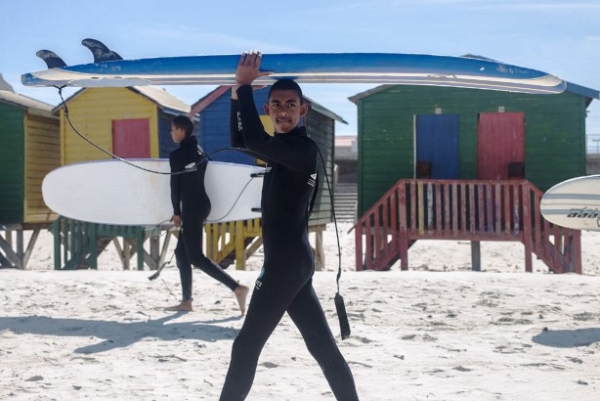Surfing helps youth at risk

A non-profit organization is using surfing to promote emotional wellbeing and mental health amongst youths who live in unstable and violent communities. Twice a week, children and teenagers from Khayelitsha, Lavender Hill and Masiphumelele head down to Muizenberg beach to surf. In the ocean, they find a safe space to have fun while building their self-confidence.

Keagan Erasmus in his wetsuit, ready to go surfing. Photo by Juliette Garms.
In 2011, Tim Conibear, a surfer from the UK, together with young South Africans Apish Tshetsha and Bongani Ndlovu, created Waves for Change. With the help of social workers and coach leaders, it provides a tight-knit structure where youngsters learn to cope with life.

Nicola Gilfelleon, one of the few girls involved in the program. Photo by Juliette Garms.
Muizenberg’s quiet parking area comes to life when two minibuses full of excited children arrive. Still in their school uniforms, they immediately start queuing in front of a container where Waves for Change stocks surfboards and wetsuits. Here, they swap their school ties for wetsuits and get ready for their weekly surf session.

Noluthano Langa gets into the water. Photo by Juliette Garms.
The initiative started with a few children from Masiphumelele. Today, the organization trains more than two hundreds kids and seventeen coaches from three different communities. ‘
“Surfing is fun and addictive,” says Conibear. “It is also risky and it attracts kids drawn to risky activity.”
Coaches are trained in social work and psychology. Over the years, the organization has developed school visits, home visits, one-to-one counseling sessions and parenting programs.

Lerenzo Hyens and Tyrees Daniel wait for the rest of the group to go to the water. Photo by Juliette Garms.
“Surf therapy is about connecting a kid to a caring adult who in turn helps them develop awareness of their emotions and coping strategies,” explains Conibear.
“Waves for Change changed my life,” says Mickaylah Pietersen, a young coach leader from Lavender Hill. “I had been involved with the wrong gang of friends. I did things I never thought I could do … Today, I feel stronger. I know that I can conquer anything that comes my way … The kids are honestly amazing. … They are really my kids, they are my family.”
“Our community is messed up. They are shooting innocent people. Working with the kids on the beach, getting them away from the community is a big help for them. They come here and we teach them about respect, discipline and communicating.”

Ashwin Pietersen and Keanan Arendolph catch a wave together. Photo by Juliette Garms.
Marleen de Villiers is also a coach leader from Lavender Hill. In January, she started working with Waves for Change. “In the beginning, they [the children] were really rough. They did not want to listen to us; they did not have discipline. But as time went on, we built a relationship and it is very good. They are achieving a lot.”

Mickaylah Pietersen leads a warm-up exercise before the surf session begins. Photo by Juliette Garms.
After a warm-up session, the children walk to the ocean, holding surfboards twice their size. In the water, laughing and screaming, they are bashed by waves. Some are already standing up on their surfboards; others are still trying, undaunted. From the beach, it is a joyful scene to watch. One hour later, the children and their coaches walk back together, joking and chatting. A queue forms again, this time for fresh oranges.
“It’s therapy for them, and it’s also therapy for us,” observes Pietersen.

Ashwin Pietersen hugs Melreen de Villiers, one of the coach leader, after the surf session. Photo by Juliette Garms.
Support independent journalism
Donate using Payfast

Don't miss out on the latest news
We respect your privacy, and promise we won't spam you.

This article is licensed under a Creative Commons Attribution-NoDerivatives 4.0 International License.
